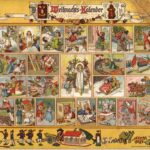
In Germany, Christmas is a deeply cherished season, woven with traditions that date back centuries and celebrated with a warmth that lights up the cold winter months. From the aroma of mulled wine wafting through bustling Christmas markets to the serene glow of candles on an Advent wreath, German Christmas traditions are a festive tapestry of cultural heritage and joyous celebration.
The Advent Season: A Time of Preparation and Anticipation
The Christmas season in Germany begins with Advent, marking a period of preparation and anticipation leading up to Christmas Eve. Homes across the country display Advent calendars, which traditionally come in various forms – from simple card calendars with little doors to elaborate wreaths made of Fir branches adorned with 24 decorated boxes containing small surprises. The Advent wreath, or ‘Adventskranz,’ is particularly significant, featuring four candles set in a ring of fir branches, with one candle lit each Sunday leading up to Christmas. This ritual, blending light and greenery, symbolizes the coming light of Christ into the world.
Christmas Trees and Decorative Delights
The Christmas tree, or ‘Tannenbaum,’ holds a place of honor in German holiday traditions. First popularized during the late Middle Ages, the practice involves the secretive decoration of the tree by parents, unveiled only on Christmas Eve to the delight of family members. Beyond the tree, German households often enhance their windows with wooden frames covered in colored plastic that light up to mimic stained glass, showcasing motifs from Scherenschnitte, traditional paper cuttings that depict Christmas scenes or nativity figures.
A Mosaic of German Gift Bringers
Germany’s folklore is rich with various Christmas gift-bringers, each associated with different regions and traditions. The Christkind, or ‘Christ Child,’ traditionally believed to deliver gifts, is depicted not as the infant Jesus but as an angelic figure, often portrayed by a young girl dressed in white and gold during festive parades, particularly famous in Nuremberg. In contrast, the secular Weihnachtsmann, akin to Santa Claus, is said to bring gifts on Christmas Eve. St. Nicholas, celebrated on December 6th, and his foreboding companions, such as Knecht Ruprecht or Krampus, are also central to the season, blending merriment with ancient lore.
Culinary Traditions: Feasts and Treats
German Christmas cuisine features an array of rich, delicious foods. On Christmas Eve, a simpler meal is customary, often featuring fish or sausages with potato salad, reflecting traditional fasting practices. The main Christmas meals on the following days might include sumptuous dishes like roast goose or duck, served with red cabbage and potato dumplings. Desserts are particularly beloved during the holiday, with Stollen – a dense, fruit-studded bread filled with marzipan – and various types of Lebkuchen, a softer, often chocolate-coated gingerbread, gracing tables across the country.
Festive Activities: Markets, Music, and More
The German Christmas market, or ‘Christkindlmarkt,’ is a highlight of the holiday season, offering everything from seasonal treats to handcrafted decorations. These markets serve as community gathering places, where people enjoy hot Glühwein, roasted chestnuts, and the festive atmosphere. Music also plays a vital role in the celebrations; from caroling to classical concerts, melodies enrich the festive spirit. Traditional songs like “Stille Nacht” (Silent Night) resonate particularly deeply, having originated in the German-speaking world.
Modern Celebrations and Global Influence
While deeply traditional, German Christmas is also a time of modern celebration and international influence. Cities like Berlin and Munich shine with elaborate light displays and bustling shopping districts, where both locals and tourists partake in the festive cheer. Moreover, Germany’s Christmas traditions have spread globally; the Christmas tree has become a worldwide symbol of the season, and German Christmas markets can now be found in cities from New York to Tokyo.
Christmas in Germany is a season enveloped in history, tradition, and warmth. From the Advent candles counting down the days to the joyous gatherings around richly decorated trees, the holiday is a time of reflection, celebration, and community. It’s these deeply rooted traditions, combined with a penchant for festive cheer, that make a German Christmas truly magical, captivating not only those who experience it firsthand but also those who adopt its customs around the world.
This extended article should now provide a comprehensive and engaging overview of Christmas traditions in Germany, resonating with the festive spirit and cultural richness that characterizes the season.
Related articles:
Forgotten German Christmas Traditions That Deserve a Comeback
History of Advent Calendars in Germany
15 Best German Christmas Recipes
Nuremberg Christmas Market
Christmas Markets and Advent in Germany
The Rich Tapestry of German Traditions
Germany’s Pagan Past: How Ancient Germanic Tribes Lived and Worshipped
The History of German Gingerbread: A Sweet Christmas Tradition







